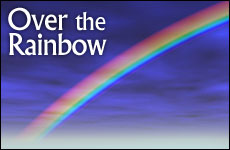 Iran’s Attack on Israel
Iran’s Attack on Israel


4 min read
Exploring the meaning of the blessing recited upon seeing a rainbow.
Judaism cultivates an appreciation of the beauty of nature, and teaches us to make special blessings when we encounter impressive natural wonders such as the sea, spectacular mountain heights, and so on.
It is hardly surprising that we also have a blessing on the rainbow, which is one of the most impressive sights in nature. But this blessing is different on the others; it doesn't focus on God's role as the Creator of the world and its beauty, but rather on the covenant with Noah which was sealed by the special sign of the rainbow (as we find in Genesis, Chapter 9). The blessing praises God "Who remembers the covenant, and is faithful in His covenant and fulfills His word."
Another remarkable thing about this blessing is that while it is praiseworthy to look at the rainbow in order to give us an opportunity to appreciate and acknowledge God's gifts, the Talmud teaches us that we should not gaze excessively at a rainbow.
Here is one way of understanding this benediction and its wording and customs.
When we "see" a rainbow, what we are really seeing is the sun as its light is refracted through a very fine cloud. Now a cloud's normal effect is to block the sun's rays so that we cannot see the sun at all. But if the cloud is fine enough, the opposite takes place: far from blocking the sun's rays, this fine mist reveals to us their true nature. Normally, we see sunlight as a simple white color, but the rainbow reveals to us that in fact the sun's rays comprise a profusion of scintillating colors -- in fact, a rainbow!
We can view this as a metaphor for our material, sublunary existence. Unfortunately, the usual effect of involvement in material affairs is to block God's spirit. Of course even the densest clouds seldom block out all sunlight, and a stormy day is still not like night. Likewise, even a person who is quite sunken in worldly affairs still apprehends a spiritual aspect to things. Such a person is not completely benighted, and the divine light still illuminates his world. However, he is unable to identify the source of this light.
Conversely, when we completely free ourselves of our attachment to matter, when we return to the World of Truth, nothing dims our perception of the source of spiritual enlightenment. There is a cloudless sky and we see the blinding clear light of Divine judgment.
However, there is an intermediate level. The truly righteous person maintains a refined involvement with this world. Such a person resembles the mist through which the rainbow shines. The Godly person demonstrates that only through measured involvement in this world can we perceive the dazzling spectrum of colors in God's rainbow.
The material world can become a lens for revealing God's splendor.
This is the covenant that God made with Noah and with mankind. The Torah introduces Noah as a righteous man who walked with God (Genesis, 6:9). Through such a person, the material world becomes a lens for revealing God's splendor -- not a fog for occluding His enlightenment. Therefore, a world founded by Noah would never need to be destroyed.
What about the prohibition of gazing at the rainbow? We have pointed out that looking at the rainbow in the sky is really a way of seeing the sun. However, if we focus our gaze on the rainbow itself, then we have lost sight of the sun and are looking at the cloud! Instead of looking through the mist, we are looking at it.
The message is that while we are able to perceive wonderful divine currents in the life of this world if we live with moderation and righteousness, we must never make the mistake of thinking that such splendor actually originates in the material world itself. This is like mistaking the rainbow for a brilliance originating in the cloud itself, which could be identified with the heresy of pantheism. We are allowed and even commanded to see the beauty in the world, as long as we use this vision to deepen our consciousness that the ultimate source of beauty is in God.
 This column is adapted from Rabbi Meir's new book, Meaning in Mitzvot, distributed by Feldheim. This two-volume work gives fascinating and profound insights encompassing the entire range of Jewish observance including prayer and holidays, kashrut and family purity, marriage customs, monetary laws, mourning, and many other topics. Rabbi Meir is the author of the weekly column The Jewish Ethicist, appearing every week in the Society Today section of Aish.com.
This column is adapted from Rabbi Meir's new book, Meaning in Mitzvot, distributed by Feldheim. This two-volume work gives fascinating and profound insights encompassing the entire range of Jewish observance including prayer and holidays, kashrut and family purity, marriage customs, monetary laws, mourning, and many other topics. Rabbi Meir is the author of the weekly column The Jewish Ethicist, appearing every week in the Society Today section of Aish.com.
